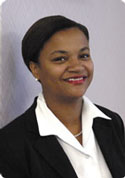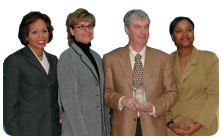 |
| volume 1, number 1 : spring 2003 |
||||
| Contents: Spring: Time for a Fresh Start Awards at 2003 NTR Program the tech transfer process: Success Depends on You spotlighting success: Goddard Technology Used to Aid Physical Therapy researcher profile: Norden E. Huang NASA Medical Technology Summits Features Three Goddard Invention 50 Attend Technology Briefing on Hilbert-Huang Transformation (HHT) Goddard Technologies Featured at NDES Tech Transfer Metrics - December 1, 2002 to February 28, 2003 Send Us Your Ideas Submit Your New Technologies |
Spring: Time for a Fresh Start |
|||
Since spring is the season of new beginnings, this is the perfect time to unveil our revised newsletter dedicated to technology transfer at Goddard. In this and future issues of Goddard Tech Transfer News, we hope to help you become actively involved in this important endeavor. |
|
|||
|
As most of you know, technology transfer is a vital part of Goddard’s mission. Your innovations and expertise are national assets that can be used not only to achieve NASA’s space program goals but also to develop new products and processes that benefit the U.S. in other ways. Therefore, your participation is imperative if we are to succeed. With this newsletter, you can learn more about Goddard’s Technology Transfer Program:
|
||||
|
The Newton White Mansion in Mitchellville was the site of the 11th annual New Technology Reporting (NTR) Program. Held April 9th and attended by civil servants who have reported new inventions to the Technology Transfer Program, the event is held every year to recognize the efforts of Goddard’s scientific and technical staff. The keynote speakers at the event were from Enduro Medical Technology, which is introducing a new product based on Goddard technology. Kenneth Messier, Patrick Summers, and Peter Summers demonstrated the Secure Ambulation Module (SAM), a walker used in physical therapy and restorative nursing. Kerley Award
Patent AwardsPatent counsel Keith Dixon presented Patent Awards to the following inventors for patents issued in 2002:
|
||||
|
||||
|
||||
| SAM is a walker with a harness that supports patients’ body weight, allowing those who cannot stand independently to receive physical therapy in a safe, stable, fall-free environment without constant attention from a therapist. SAM’s key feature is Goddard’s cable-compliant joint (CCJ) technology, which allows the harness to control the patient’s pelvis. The CCJ technology, which consists of connected cable segments, provides stability while allowing subtle twisting and cushioning and providing shock absorption and energy damping. Because of the CCJ technology, SAM can provide several important benefits, including reduced injuries for patients and therapists, a faster path to rehabilitation, significant medical benefits, and increased staff efficiency. | 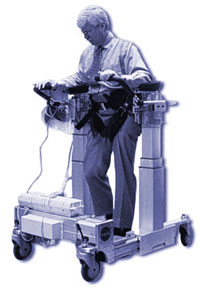 |
Kerley invented the CCJ technology and later teamed up with Eklund and Crane to develop an early version of the walker. Enduro licensed the CCJ technology and walker, developing a commercially viable product that is expected to revolutionize physical therapy and restorative nursing.
![]()

researcher profile:
Norden E. Huang
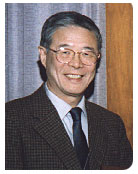 |
Code 971 |
What invention are you currently working to transfer?
The Hilbert-Huang transformation (HHT) technology, which is a new method for time-frequency-energy analysis. HHT algorithms accurately analyze nonlinear, nonstationary energy frequencies as a function of time, providing a superior alternative to fast Fourier transformation (FFT). HHT can be used in a wide range of applications, including analysis of underwater acoustic signals; design of noise-blocking headphones; structure and machine health diagnosis; earthquake monitoring; and heart rate, blood pressure, or other biomedical monitoring.
What has the Technology Transfer Program done to introduce your invention to new users?
Program staff prepared a Technology Opportunity Sheet, which has been used to solicit partners for continued development and licensing. They also submitted the application to win an R&D 100 Award and the Federal Laboratory Consortium award for excellence in technology transfer. They also have recommended me for the Special Space Act Award three times, which carries cash awards, as well as nominated me for the Invention of the Year Award. This year they arranged for me to present at the NASA Medical Technology Summit and organized a technology briefing for industry, academia, and government to learn more about HHT.
What do you see as the future for your technology?
I see HHT becoming as widespread as FFT, for HHT can produce the identical results as FFT if the processes producing the data are linear and stationary. If the processes are nonlinear and nonstationary, HHT gives more meaningful results. As such, HHT could be viewed as a generalized Fourier analysis method.
Any advice for your colleagues?
Think the unthinkable and examine the fundamentals more critically. In doing so, you might find a simple method that represents a conceptual departure from accepted methods.
![]()

NASA Medical Technology Summit Features Three Goddard Inventions
 |
On February 11-13, NASA hosted nearly 200 attendees from industry, academia, and government agencies at the NASA Medical Technology Summit: Forging Partnerships to Commercialize Emerging Medical Technologies. By introducing industry leaders to NASA’s most exciting and innovative medical technologies, the summit sought to stimulate joint development and licensing partnerships with industry.
|
Among the more than 20 NASA technologies featured at the summit were three developed at Goddard:
- Hilbert-Huang transformation (see article below), which can be used to analyze heart rate, blood pressure, and other biological signals, developed by Norden Huang (Code 971)
- Single-walled carbon nanotubes, which can be used in pacemakers, implantable biosensors, hearing aids, and other medical devices, developed by Jeannette Benavides (Code 562)
- Sol-gel filled fiber optics, which can be used in biosensors, developed by Harry Shaw, Melanie IPP, and Michele Manuel (Code 562)
In addition to hearing presentations on these and other NASA technologies, attendees were able to meet one-on-one with inventors and technology transfer staff. Goddard inventors participated in eight such meetings. Said Benevides, "I learned a lot about how to bring together R&D and technology transfer and also how valuable this transition is."
Technology Transfer Program staff are following up with the National Institutes of Health and companies that expressed interest in Goddard’s inventions.
![]()

50 Attend Technology Briefing on Hilbert-Huang Transformation (HHT)
What do the FBI, the Federal Highway Administration, the University of Delaware, and Bartron Medical Imaging have in common? They all attended the March 24th HHT Advanced Analysis Software Technology Briefing, and they are now working with Goddard to transfer the technology to the marketplace.
The briefing was attended by representatives from several companies, universities, and government agencies. Presentations explored the potential applications for the HHT technology:
- Biomedical signal analysis
- Speech analysis
- Machine tool fault detection
- Vibrometers
- Data processing
These presentations were followed by one-on-one meetings, where seven organizations discussed possible partnerships with inventor Norden Huang and Technology Transfer Program staff.
"HHT is a particularly exciting tech transfer effort because of its potential internally to NASA as well as externally," said Nona Cheeks, Chief of Goddard’s Technology Transfer Program. "NASA’s goals are broad: to improve life on Earth, to take ourselves outside the confines of Earth, and to discover life beyond Earth. HHT can help in all of these aspects."
![]()

Goddard Technologies Featured at NDES
This year’s National Design and Engineering Show (NDES)-held at National Manufacturing Week March 3-6 in Chicago, Illinois-included a new event designed to bring together companies looking for technical solutions and the research labs that might meet their needs. The Technology Transfer Conference and Expo was an ideal opportunity to present potential licensees with several Goddard technologies:
|
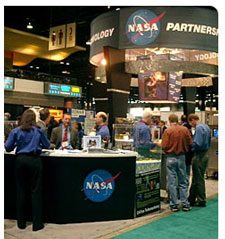 |
The Technology Transfer Program not only organized technology briefings for two of these technologies but also scheduled one-on-one meetings with representatives from interested companies. "These meetings not only allowed us to gauge the interest of the companies, but they also gave industry a more in-depth look at our technologies," explained Joe Famiglietti of the Technology Transfer Program. Goddard held 12 of these one-on-one meetings during NDES.
![]()

Tech Transfer Metrics
December 1, 2002 to February 28, 2003
New technologies reported: 22
Civil Servants
- Jason Budinoff
(Code 544)
- Amy Fedorchak
(Code 547)
- Gregory Greer
(Code 545)
- Jessica Hauss
(Code 551)
- Virginia Kalb
(Code 922)
- Jacqueline LeMoigne-Stewa (Code 935)
- Nargess Memarsadeghi
(Code 588)
- Rajeev Sharma
(Code 544)
- John Vranish
(Code 544)
- Howard Wood
(Code 551)
Contractors
- CSA Engineering Inc.
- Hughes Aircraft Company
- Luxel Corp.
- Mathsoft Inc.
- Nanosciences Corp.
- QSS Group Inc.
- Space Telescope -European Coordinating Facility
- Swales & Associates Inc.
Universities
- Case Western Reserve University
- Cornell University
- Johns Hopkins University
- Southern University -Baton Rouge
- Stanford University
- University of Chicago
- University of Maryland - College Park
- University of Washington
Provisional Patents Filed: 4
- Holographic Plossl Retroreflector, Eugene Waluschka (Code 551)
- Half Tooth Gear Bearings, John Vranish (Code 544)
- Conceptual Design of a 3D Imaging Lidar for High-Resolution Mapping of the Surface Topography of Moons or Planets from Space, John Degnan (Code 920)
- Real-Time Software Receiver, Brent Ledvina, Mark Psiaki, Steven Powell, Paul Kintner (contractors)

Send Us Your Ideas
We want to do all we can to make it easy and rewarding for you to participate in the Technology Transfer Program. But we need your help. Send us your ideas for program improvements or News articles via email.
![]()

Submit Your New Technologies
You can report new project technologies by submitting the online form on eNTRe.
And watch for the next issue of Goddard Tech Transfer News, where we will unveil a new submission system that further simplifies the NTR paperwork.
![]()

A publication of
Technology Transfer Program
Mailstop 504
Building 22, Room 290
(301) 286-5810
techtransfer@tco.gsfc.nasa.gov
